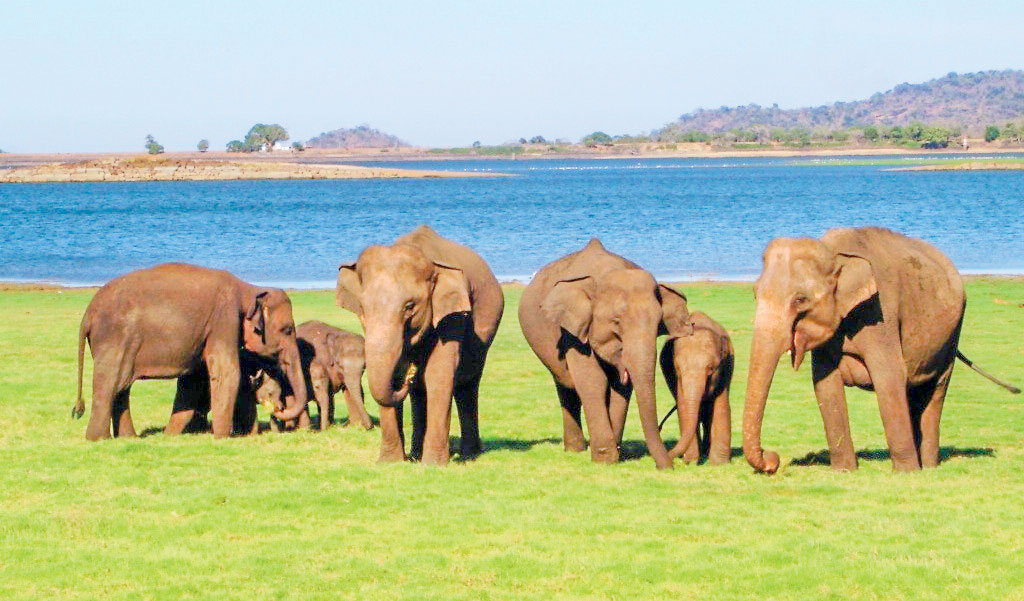Excerpts from P Dayaratne’s autobiographyby KKS PERERAWhile translating the Sinhala autobiography of P. Dayaratne, the former District and Cabinet Minister who represented Ampara (Digamadulla) in Parliament for an uninterrupted 38 years, this writer came across an intriguing chapter featuring a vivid recollection of the Kumana bird sanctuary located to the east of the Yala National Park, which is the largest natural resource in Panampattuwa.Its community leader was Charles Lambert Leonidas, an alumnus of St.
Thomas’, the renowned school by the sea, according to Dayaratne, a gentle and dignified politician. Evidence suggests the people of Kumana village have lived there for generations, with some possibly being descendants of those who fled following the Uva-Wellassa rebellion.The Kumana bird sanctuary, located on the eastern side of Yala National Park, is one of Panama’s greatest natural treasures.

Dayaratne, deeply passionate about environmental conservation, played a key role in preserving this invaluable sanctuary.Leonidas opposed relocationDayaratne was aware of Leonidas, a Thomian fluent in English, who was well-liked by tourists. Initially appointed as an English teacher at Panama Maha Vidyalaya, Leonidas was later transferred to a school in Kumana after conflicts with the Batticaloa education authorities.
Panampattuwa is rich in ancient sites reclaimed by the wilderness, including Kotavehera, Bambaragastalawa, Kongaswewa, and Karanda Hela. While scholars must research and interpret these sites, their preservation is a duty of the local community, with legal protection being the government’s responsibility.Dayaratne, an electrical engineer with a deep passion for nature, regarded the Kumana bird sanctuary as a national treasure.
The bird colonies in its lagoons are among Asia’s most significant, offering both an ecological resource and a breathtaking sight for nature enthusiasts. Migratory birds from Siberia reach Kumana as their final stop, with no landmass further south—a phenomenon still studied by scientists.Kumana’s villagers thrived entirely off the forest, facing fewer challenges than those in developed areas.
They gathered honey, hunted deer and buffalo, and sold wood apples to buy essentials like salt and dried fish. Living simply, they had little interest in luxury. Unlike other voters, they made no demands for electricity, piped water, or telephones, yet remained content—a way of life Dayaratne deeply admired.
In contrast, the lifestyle in other regions was vastly different. People there worked tirelessly day and night to accumulate wealth, constantly striving for positions, rank and status. When their expectations were unmet, they complained, harbored resentment, and felt envy.
Some even plotted against others. However, such traits were absent among the people of Kumana. They led simple lives, coexisting harmoniously as an interconnected community where everyone was related to one another.
Panama is home to many ancient sites overgrown by nature. Among them, Kotavehera, Bambaragasthalawa, Kongaswewa, and Karandahela stand out as significant locations. While scholars are responsible for conducting research and providing historical analyses of these sites, it is the commitment of the local communities that ensures their preservation.
The government, in turn, must enforce appropriate legal measures to protect them says, the former minister.During his time in Kumana, Leonidas married a young woman from the village. However, his arrogant nature eventually led to his downfall.
While he was a leader to the uneducated villagers, his command of English enabled him to mediate between the villagers and visiting government officials or politicians at the Kumuna Sanctuary. Through these connections, he was able to facilitate certain benefits for the local people.Leonidas opposed relocation of Kumana villagers Living within a wildlife reserve.
Before becoming Minister of Mahaweli Development, Dayaratne had attempted to relocate the Kumana villagers to another area, but his efforts were unsuccessful. Previous ministers had also attempted this relocation plan but failed. Despite the Department of Wildlife Conservation’s urgent program to remove the Kumana settlement, their efforts were thwarted by human rights organizations that opposed the move.
Thirty houses were built near Kudumbigala Aranya Senasana to relocate Kumana villagers during State Minister Anandatissa de Alwis’s tenure. However, the project failed—elephants destroyed most houses, and looters stole the materials.Developing Kumana was difficult.
Despite Dayaratne’s efforts as Minister of Mahaweli Development, strict Wildlife Conservation regulations restricted land use, leading him to consider relocating villagers to Mahaweli settlements. Ven. Thambugala Anandasiri Thero, the former head monk of Kudumbigala, transformed the rugged area into a haven for meditative monks.
Tragically, Sinhala extremists assassinated him, despite his political neutrality. Dayaratne, who knew him personally, mourned his loss.At the Mahaweli Ministry, Dayaratne found the Mahaweli Authority and the Wildlife Department merged under a single ministry, easing coordination.
Seeing an opportunity, he pursued the Kumana resettlement project. However, a foreigner residing in Kumana fiercely opposed it. Undeterred, Dayaratne remained committed to relocating the villagers for their well-being.
Around this time, President Ranasinghe Premadasa visited the Eastern Province, providing Dayaratne with an opportunity to push his forward his agenda. He proposed to the President that they visit Kumana, and Premadasa agreed. Traveling there by helicopter, they encountered villagers who were hesitant to travel through the jungle to Panama due to fears of terrorist attacks.
Peacock at KumanaA meeting was arranged between the President and the villagers, during which the proposal to relocate them to the Mahaweli settlements was presented. Leonidas, as the de facto village leader, firmly refused to leave Kumana, accusing the government of attempting a forced eviction. President Premadasa listened attentively to all arguments.
Dayaratne then explained to the President the benefits that would be provided to those who agreed to relocate. Each family would receive two acres of paddy land and half an acre of highland, with roads built to ensure access to their new homes. Additionally, they would receive financial assistance until their first harvest.
Despite these assurances, Leonidas remained adamantly opposed to the plan. President Premadasa, taking all factors into account, carefully considered the next course of action.Dayaratne ensured that all necessary relief was provided, yet there was no indication that Leonidas would withdraw his opposition.
President Premadasa remained unmoved. It is likely that the President believed Leonidas was merely representing the sentiments of the villagers. Even Dayaratne himself considered Leonidas’ love for the village and his perspective to be justifiable.
However, allowing people to reside within a national park was entirely unacceptable, as it offered them no prospect of development.While the situation remained tense, a young man seated at the back suddenly stood up and declared that, apart from six families, all others were willing to leave the village and relocate to the Mahaweli lands. A sense of relief washed over Dayaratne upon hearing this statement.
There was little Leonidas could argue against, as only six families remained in support of his stance. Eventually, about 25 families were relocated to Mahaweli territory.At that time, the Department of Wildlife managed two tourist bungalows in Okanda and Thunmulle, but both were destroyed by insurgents during a period of intense terrorist activity.
As violence escalated, Leonidas and six families who had initially refused to move were forced to abandon the village and seek refuge in Panama.Later, news spread that Leonidas had died suddenly on the grounds of Panama Maha Vidyalaya at around 80-years of age.Dayasena was the son of Kiriya Piyadasa, a respected village leader in Kumana who owned a small shop.
Piyadase was beloved by the villagers and ensured that his daughter, Podi Nona, received her education at Vishaka Vidyalaya in Badulla. Upon completing her studies, Piyadasa helped her secure a teaching position during President Premadasa’s tenure. She later became the principal of the Kumana village school and ensured her children received quality education by enrolling them in Badulla schools.
At that time, appointing a Grama Niladhari for Kumana was challenging. The village’s administration was handled by the officer from Panama, 23 miles away. Although separate officers were occasionally appointed, none were willing to serve in Kumana.
To resolve this, the Minister of Public Administration, Montague Jayawickrame, submitted a special cabinet paper, leading to Piyadasa Dayasena’s appointment as Grama Niladhari despite his limited qualifications.Podi Nona’s daughters to EnglandOne of Podi Nona’s daughters eventually migrated to England and built a successful life there. Dayaratne learned of this when he and his wife met her in Colombo.
She expressed gratitude for the opportunities that had shaped her family’s future, emphasizing that had they remained in the dense forests of Kumana, such progress would have been impossible. She also mentioned that her parents had received land in the Mahaweli region which had transformed their lives.Tragically, in the eastern region, a group of wildlife officers, including the Assistant Director of Wildlife, was brutally murdered by terrorists in Kumana.
This incident severely disrupted the Wildlife Department’s operations in the area.The primary sources of income in Panama were paddy farming and chena cultivation, with some villagers also engaged in fishing. In earlier times, a few resorted to hunting for food.
However, with the rise of LTTE terrorism, hunting ceased entirely as people avoided venturing into the forest for fear of both terrorists and the Special Task Force (STF). From an environmental perspective, the writer found relief in knowing that wildlife had been spared from further hunting.The people of Panama led simple, peaceful lives.
Due to the village’s isolation, they were slow to adopt modern social changes. It remains uncertain whether any other village in the country could compare to Panama in terms of its seclusion and traditional way of life.Dayaratne recalled the kindness shown to him by several individuals in this village over the years.
Some actively supported his electoral campaigns, while others were respected figures who had held key positions in the community. Among them, he specifically remembered two old friends: Heen Banda Somasundaram and N.J.
Dhanabalasingham, whose generous hospitality he deeply appreciated. He also acknowledged political activists such as Kanakasabe, Gunaratna, Obeysekera, Dinaratna, Kalubanda, and Wijerathna, all of whom had since passed away. Dinaratna, notably, had been married to Heen Banda Somasundaram’s daughter.
In subsequent years, Babban Appu Jayathilaka, Rasaiah Chandrasena, and Lalee Kulnayake emerged as prominent activists. Babban Appu Jayathilaka, who contested under the United National Party, had served as chairman of the Lahugala Pradeshiya Sabha for a time. Rasaiah Chandrasena, a teacher by profession, later held the same position after winning an election.
[email protected].
Top

The old Thomian who led Kumana villagers

Excerpts from P Dayaratne’s autobiography by KKS PERERA While translating the Sinhala autobiography of P. Dayaratne, the former District and Cabinet Minister who represented Ampara (Digamadulla) in Parliament for an uninterrupted 38 years, this writer came across an intriguing chapter featuring a vivid recollection of the Kumana bird sanctuary located to the east of the [...]











